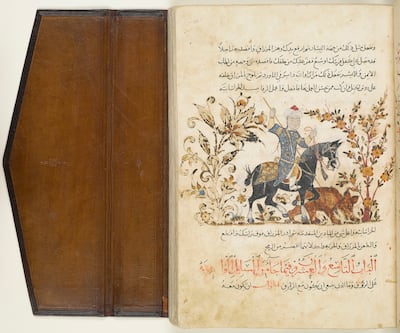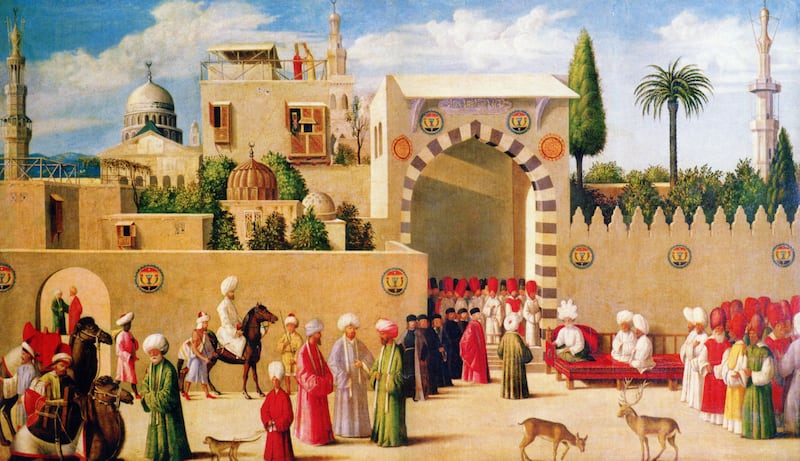The mid-13th century was a period of terror and upheaval in the Middle East as the Mongols rampaged across areas that are now Iran and Iraq, destroying cities and leaving “towers of skulls” in their wake.
Its apotheosis was the fall of Baghdad to the horde in 1258 when a large part of its inhabitants were massacred, with the Abbasid caliph al-Musta’sim rolled up in a carpet and trampled to death.
However, when Mongol envoys arrived in Cairo demanding immediate submission, the Mamluk sultan Saif ad-Din Qutuz chose to resist, ordering them to be put to death. At the battle of Ain Jalut in the Galilee, the Mongols were decisively defeated by the army under Qutuz’s command.
As John Brunton writes in the introduction to The Mamluks: Slave Warriors of Medieval Islam: “The entire civilisation of medieval Islam came close to the edge of destruction when the Mongols sacked Baghdad. But the Mamluks, a cadre of freed slave soldiers, seized control in Egypt and ruled that land and Syria, fighting off attacks first from the west and then the east.”

The Mamluks not only defended the region from the invading Mongols but also conquered the Outremer – the Crusaders' states of the Levant, some of whom supported the horde.
Brunton’s history interlaces the Mumluk’s battlefield prowess with their unique origin story. Few empires in history offered slaves the opportunity to become rulers with the Mamluks of Egypt among the few exceptions (another was the Slave Dynasty of India, which also arose in the 13th century).
The early Mamluks included many Kipchak Turks, originating from the lower Volga region, who “gained a reputation for their aggressive nature, even among their Turkish neighbours". The sourcing of slaves wasn’t always by total coercion.
Brunton writes: “The Turks came to hear of the rich and plentiful land of Egypt and the prospects a Turkish slave could find there, parents in the Kipchak lands would often willingly sell their children into slavery. Children could be a liability in this harsh nomadic lifestyle, and enslavement promised far more than the steppes ever could.”
Besides Turks, there were sizable numbers of Circassian mamluks, originally from the Caucasus Mountains. Brunton narrates how in the 14th century when Turks were not so easily found in the slave markets, they were replaced almost entirely by Circassians.
There were also Mamluks who were Mongols, Anatolians, Bosnians and Armenians. However, all had Turkish names and spoke Turkish in the Kipchak dialect, although their sons, known as the awlad-an-nas (the sons of the people) formed a link with the natives, and “had Arabic names and lived like Egyptians".

The most famous Mamluk ruler was Rukn-ad-Din Baibars al-Bunduqdari, a freed slave who proved his mettle on the battlefield fighting Mongols and Franks, eventually taking on the mantle of sultan. Although fourth in line to the throne, Brunton describes Baibars as “the true founder of the Mamluk sultanate”, writing that along with Saladin and Harun-ar-Raschid he “ranks with the most prominent figures of Muslim legend".
During the battle of Ain Jalut, Baibars deployed the Mongol’s own deceptive tactics to help defeat them. When the Mongols thought they were pursuing retreating Mamluks, they were taken by surprise when concealed troops appeared, losing their arrows and surrounding the Mongols.
After the destruction of Abbasid Baghdad by the Mongols, the torch of enlightenment and learning was passed to the Mamluks. Brunton narrates how a physician named Ibn an-Nafis discovered the pulmonary circulation of blood three centuries before its credited discovery in Europe by William Harvey.
Famous written works that appeared under the Mamluks include Moroccan scholar Ibn Khaldun’s masterpiece al-Muqadimma, which Brunton calls the first attempt by a historian to show a pattern in the changes occurring in society and government.
He writes that even the Arabian Nights stories, which originated in an oral storytelling tradition, were transcribed during the Mamluk period, with “the flavours of 14th-century Cairo" transposed to the Baghdad of Harun-ar-Raschid.
Mamluk architecture can still be found in Cairo today, such as the exquisite Blue Mosque of Aqsunqur or the large 14th-century Mosque-Madrassa of Sultan Hasan.
Brunton has produced a comprehensive and engaging account of an often ignored chapter in medieval history, one that throws deep questions about power and systems of governance that still hold relevance today.
The slave origins of the Mamluk empire were deeply rooted in the insecurities and suspicions of medieval rulers, who believed freed slaves to be more trustworthy than their own kin and close advisors.
For Brunton, it’s too simplistic to see the relationship between a Mamluk and his former master as one of gratitude, writing that they depended on their patrons for sustenance and self-advancement. Discerning readers may find their own interpretation behind the rise and fall of this unusual empire.
The Mamluks: Slave Warriors of Medieval Islam is due to be released on October 15






